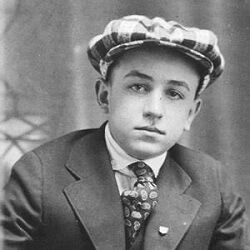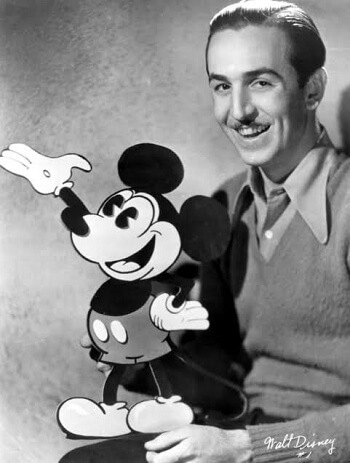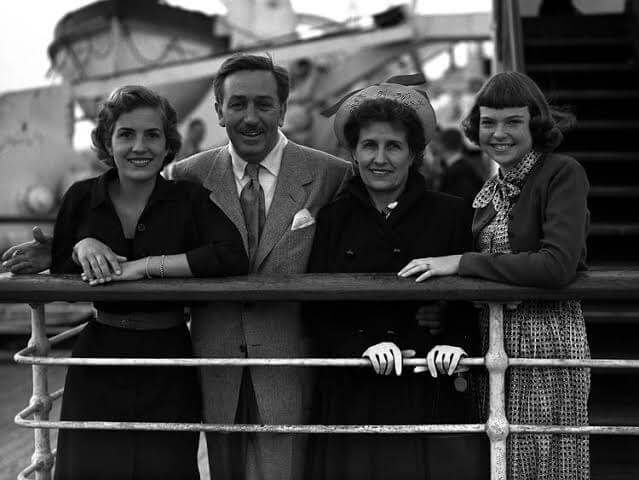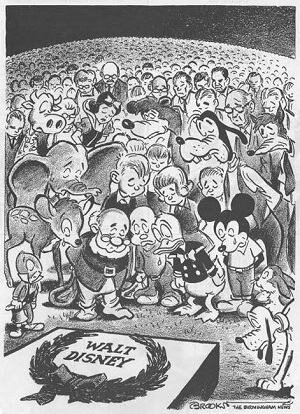Walt Disney
Disney, who was born in Chicago in 1901, developed an early interest in drawing. He studied art as a child and became a commercial illustrator at the age of 18. In the early 1920s, he relocated to California and founded the Disney Brothers Studio with his brother Roy. In 1928, he co-created the character Mickey Mouse with Ub Iwerks; in the early years, he also provided the voice for his creation. As the studio expanded, he became more daring, introducing synchronized sound, full-color three-strip Technicolor, feature-length cartoons, and camera technological advances. The results, seen in films like Snow White and the Seven Dwarfs (1937), Pinocchio, Fantasia (both 1940), Dumbo (1941), and Bambi (1942), helped to advance the development of animated films. Following World War II, new animated and live-action films were released, including the critically acclaimed Cinderella (1950) and Mary Poppins (1964), the latter of which received five Academy Awards. Disney expanded into the amusement park industry in the 1950s, and in July 1955, he opened Disneyland in Anaheim, California. To finance the project, he ventured into television shows like Walt Disney's Disneyland and The Mickey Mouse Club. He also worked on the 1959 Moscow World's Fair, the 1960 Winter Olympics, and the 1964 New York World's Fair. In 1965, he began work on another theme park, Disney World, the centerpiece of which was to be a new type of city called the "Experimental Prototype Community of Tomorrow" (EPCOT). Disney smoked heavily throughout his life and died of lung cancer in December 1966, before the park or the EPCOT project was completed. In private, Disney was a shy, self-deprecating, and insecure man who adopted a warm and outgoing public persona. He had high standards and expectations of those he worked with. Although there have been accusations that he was racist or anti-Semitic, many people who knew him had refuted these claims. In the years following his death, his reputation shifted from that of a purveyor of homely patriotic values to that of a representative of American imperialism. Nonetheless, he is regarded as a national cultural icon in the United States and remains an important figure in the history of animation. His film work is still shown and adapted, and the Disney theme parks have grown in size and number to attract visitors in the years since. Childhood
On December 5, 1901, at 1249 Tripp Avenue in Chicago's Hermosa neighborhood, Walt Disney was born. He was the fourth child of Elias Disney, who was born in the Province of Canada to Irish parents, and Flora (née Call), an American of German and English ancestry. Aside from Walt, Elias and Flora's sons were Herbert, Raymond, and Roy; and in December 1903, the couple welcomed a fifth child, Ruth. When Disney was four years old, his family relocated to a farm in Marceline, Missouri, where his uncle Robert had recently purchased land. Disney's interest in drawing began in Marceline when he was paid to draw the horse of a retired neighborhood doctor. Elias read the Appeal to Reason newspaper, and Disney practiced drawing by copying Ryan Walker's front-page cartoons. He also began to hone his skills with watercolors and crayons. He grew up near the Atchison, Topeka, and Santa Fe Railway line and became fascinated by trains. In late 1909, he and his younger sister Ruth began school at the Park School in Marceline. The Disneys were committed members of a Congregational church. The Disneys relocated to Kansas City, Missouri, in 1911. Disney attended Benton Grammar School, where he met fellow student Walter Pfeiffer, who came from a theatrical family and introduced him to the worlds of vaudeville and motion pictures. Disney soon found himself spending more time at the Pfeiffers' house than at his own. Elias had purchased a route for The Kansas City Star and The Kansas City Times. Disney and his brother Roy got up at 4:30 every morning to deliver the Times before school and then repeated the process after school for the Evening Star. The schedule was demanding, and Disney frequently received poor grades as a result of falling asleep in class, but he stuck with his paper route for more than six years. He took Saturday classes at the Kansas City Art Institute as well as a cartooning correspondence course. In 1917, Elias purchased stock in the O-Zell Company, a Chicago jelly manufacturer, and returned to the city with his family. Disney enrolled at McKinley High School and became the school newspaper's cartoonist, drawing patriotic images about World War I. He also attended night classes at the Chicago Academy of Fine Arts. He attempted to join the United States Army to fight the Germans in mid-1918 but was turned down because he was too young. In September 1918, he joined the Red Cross as an ambulance driver after forging his birth certificate's date of birth. He was shipped to France but did not arrive until November, after the armistice. He drew cartoons on the side of his ambulance for decoration and had some of his work published in the army newspaper Stars and Stripes. In October 1919, he returned to Kansas City to work as an apprentice artist at the Pesmen-Rubin Commercial Art Studio, where he drew commercial illustrations for advertising, theatre programs, and catalogs and befriended fellow artist Ub Iwerks. Career1920-1928As Pesmen-revenue Rubin's fell after Christmas, Disney, then 18, and Iwerks were laid off in January 1920. They formed their own company, Iwerks-Disney Commercial Artists, which was short-lived. After failing to attract many customers, Disney and Iwerks agreed that Disney should leave temporarily to work for A. V. Cauger's Kansas City Film Ad Company; the following month, Iwerks, who was unable to run their business alone, also joined. The company used the cutout animation technique to create commercials. Disney developed an interest in animation, though he preferred hand-drawn cartoons like Mutt and Jeff and Koko the Clown. He began experimenting at home with the help of a borrowed book on animation and a camera. He concluded that cel animation was more promising than cutout animation. Unable to persuade Cauger to try cel animation at the company, Disney formed a new company with a Film Ad Co coworker, Fred Harman. The local Newman Theater was their main client, and the short cartoons they created were marketed as "Newman's Laugh-O-Grams." As a model, Disney looked to Paul Terry's Aesop's Fables, and the first six "Laugh-O-Grams" were modernized fairy tales. The success of the "Laugh-O-Grams" led to the formation of the Laugh-O-Gram Studio in May 1921, for which he hired more animators, including Fred Harman's brother Hugh, Rudolf Ising, and Ub Iwerks. The Laugh-O-Grams cartoons did not generate enough revenue to keep the company afloat, so Disney began work on Alice's Wonderland, a live-action/animation hybrid based on Alice's Adventures in Wonderland, with Virginia Davis in the title role. The end result was a 12-and-a-half-minute, one-reel film that was too late to save Laugh-O-Gram Studio, which went bankrupt in 1923. At the age of 21, Disney moved to Hollywood in July 1923. Despite the fact that New York was the cartoon industry's epicenter, he was drawn to Los Angeles because his brother Roy was recovering from tuberculosis there, and he hoped to become a live-action film director. Until he heard from New York film distributor Margaret J. Winkler, Disney's efforts to sell Alice's Wonderland were futile. She needed a new series because she was losing the rights to both the Out of the Inkwell and Felix the Cat cartoons. They signed a contract in October for six Alice comedies, with an option for two additional series of six episodes each. To produce the films, Disney and his brother Roy established the Disney Brothers Studio, which later became The Walt Disney Company; they persuaded Davis and her family to relocate to Hollywood to continue production, with Davis on a $100-per-month contract. In July 1924, Disney hired Ub Iwerks, convincing him to relocate from Kansas City to Hollywood. By 1926, Winkler's role in the distribution of the Alice series had been transferred to her husband, film producer Charles Mintz, though his relationship with Disney was occasionally strained. The series lasted until July 1927, when Disney grew tired of it and decided to switch from the mixed format to all animation. After Mintz requested new material for Universal Pictures to distribute, Disney and Iwerks created Oswald the Lucky Rabbit, a character Disney wanted to be "peppy, alert, saucy, and venturesome, while remaining neat and trim." In February 1928, Disney attempted to negotiate a higher fee for producing the Oswald series, but Mintz refused. Mintz had also persuaded many of the artists involved, including Harman, Ising, Carman Maxwell, and Friz Freleng, to work directly for him. Disney also discovered that Universal owned Oswald's intellectual property rights. If Disney refused to accept the reductions, Mintz threatened to start his own studio and produce the series himself. Disney turned down Mintz's ultimatum and lost most of his animation staff, with the exception of Ub Iwerks, who chose to stay with him. Mickey Mouse's Creation to the First Academy Awards: 1928-1933
To replace Oswald, Disney and Iwerks created Mickey Mouse, who was possibly inspired by a pet mouse that Disney had adopted while working in his Laugh-O-Gram studio, though the character's origins are unknown. Mortimer Mouse was Disney's first choice for a name, but Lillian thought it was too pompous and suggested Mickey instead. To make the character easier to animate, Iwerks revised Disney's preliminary sketches. Mickey's voice was provided by Walt Disney, who had begun to distance himself from the animation process until 1947. "Ub designed Mickey's physical appearance, but Walt gave him his soul," according to one Disney employee. Mickey Mouse first appeared in a single test screening of the short Plane Crazy in May 1928, but it and the second feature, The Gallopin' Gaucho, were both unsuccessful in finding a distributor. Following the success of The Jazz Singer in 1927, Disney created the first post-produced sound cartoon with the third short, Steamboat Willie. Following the completion of the animation, Disney signed a contract with former Universal Pictures executive Pat Powers to use the "Powers Cinephone" recording system; Cinephone became the new distributor for Disney's early sound cartoons, which quickly became popular. To improve the quality of the music, Disney hired professional composer and arranger Carl Stalling, who suggested the Silly Symphony series, which told stories through music; the first in the series, The Skeleton Dance (1929), was entirely drawn and animated by Iwerks. Several local artists were also hired at this time, some of whom stayed with the company as core animators; the group later became known as the Nine Old Men. Both the Mickey Mouse and Silly Symphonies series were successful, but Disney and his brother felt that Powers was not paying them their fair share of profits. In 1930, Disney attempted to cut costs by urging Iwerks to abandon the practice of animating each individual cel in favor of the more efficient technique of drawing key poses and letting lower-paid assistants sketch the in-between poses. Disney requested an increase in payments for the cartoons from Powers. Powers refused and hired Iwerks; Stalling resigned soon after, believing that without Iwerks, the Disney Studio would close. Disney had a nervous breakdown in October 1931, which he blamed on Powers' schemes and his own overwork, so he and Lillian went on an extended vacation to Cuba and a cruise to Panama to recover. Following the departure of Powers as a distributor, Disney Studios signed a deal with Columbia Pictures to distribute the Mickey Mouse cartoons, which became increasingly popular, including internationally. Disney, who was always eager to embrace new technology, shot Flowers and Trees (1932) in full-color three-strip Technicolor; he was also able to negotiate a deal that gave him exclusive use of the three-strip process until August 31, 1935. The following Silly Symphony cartoons were all in color. Flowers and Trees were well-liked by audiences, and it received the first Academy Award for Best Short Subject (Cartoon) at the 1932 ceremony. Disney had previously been nominated in that category for another film, Mickey's Orphans, and had received an Honorary Award "for the creation of Mickey Mouse." Golden Era of Animation: 1934-1941By 1934, Disney had grown tired of making formulaic cartoon shorts and believed that a feature-length cartoon would be more profitable. The four-year production of Snow White and the Seven Dwarfs, based on the fairy tale, began. When word of the project leaked out, many in the film industry predicted it would bankrupt the company; insiders dubbed it "Disney's Folly." The film, which was the first in full color and sound, cost $1.5 million to produce - three times the budget. To ensure that the animation was as realistic as possible, Disney sent his animators to the Chouinard Art Institute, brought animals into the studio, and hired actors to study realistic movement. Disney animators created a multiplane camera that allowed drawings on pieces of glass to be set at various distances from the camera, creating the illusion of depth. The glass could be moved to simulate a camera moving through the scene. Snow White premiered in December 1937 to critical and audience acclaim. The film was the most successful motion picture of 1938, and its total gross of $6.5 million by May 1939 made it the most successful sound film made to that point. Disney received an additional Honorary Academy Award, which included one full-sized and seven miniature Oscar statuettes. The success of Snow White heralded one of the studio's most productive eras; the Walt Disney Family Museum refers to the years that followed as the "Golden Age of Animation." Theme Parks, Television, and Other Interests: 1950-1966
In early 1950, Disney released Cinderella, his studio's first animated feature in eight years. Both critics and theatergoers received it well. It cost $2.2 million to produce and earned nearly $8 million in its first year. Disney was less involved than he had been in previous films due to his involvement in his first entirely live-action feature, Treasure Island (1950), which was shot in Britain, as was The Story of Robin Hood and His Merrie Men (1952). Other all-live-action films followed, many with patriotic themes. He also continued to make full-length animated films, such as Alice in Wonderland (1951) and Peter Pan (1953). Disney had been considering constructing a theme park for several years. When he took his daughters to Griffith Park in Los Angeles, he wanted to be in a clean, unspoiled park where both the children and their parents could have fun. He visited Tivoli Gardens in Copenhagen, Denmark, and was greatly influenced by the park's cleanliness and layout. In March 1952, he received zoning approval to build a theme park near the Disney studios in Burbank. On Christmas Day 1950, the studio was involved in a successful television special about the making of Alice in Wonderland. Roy believed the program increased box office receipts by millions of dollars. In a letter to shareholders dated March 1951, he stated that "Television can be a very effective selling tool as well as a source of revenue for us. We will almost certainly enter television on this premise ". After the funding for Disneyland was agreed upon, ABC aired Walt Disney's Disneyland, an anthology of animated cartoons, live-action features, and other material from the studio's library, in 1954. Aside from the studio, Disney worked on other projects. He served as a consultant for the 1959 American National Exhibition in Moscow, and Disney Studios' contribution was America the Beautiful, a 19-minute film shown in the 360-degree Circarama theatre, which was one of the most popular attractions. He served as chairman of the Pageantry Committee for the 1960 Winter Olympics in Squaw Valley, California, where he designed the opening, closing, and medal ceremonies. In 1966, Disney sought out companies willing to sponsor EPCOT. In the 1966 film Lt. Robin Crusoe, U.S.N., he appeared as Retlaw Yensid, his name spelled backward. He became more involved in the studio's films and was heavily involved in the story development of The Jungle Book, The Happiest Millionaire (both 1967), and Winnie the Pooh and the Blustery Day (both 1968). Personal Life
Lillian Bounds, an ink artist, was hired by Disney in early 1925. They married in July of that year at her brother's home in Lewiston, Idaho. According to Lillian, the marriage was generally happy, though she did not "accept Walt's decisions meekly or his status unquestionably, and she admitted that he was always telling people 'how henpecked he is," according to Disney's biographer Neal Gabler. Lillian had little interest in films or the Hollywood social scene, and she was "content with household management and providing support for her husband," according to historian Steven Watts. Diane (born December 1933) and Sharon were their two daughters from their marriage (adopted in December 1936, born six weeks early). Within the family, neither Disney nor his wife concealed Sharon's adoption, though they became irritated when people outside the family brought it up. The Disneys were careful to keep their daughters as far away from the public eye as possible, especially in light of the Lindbergh kidnapping; Disney took steps to ensure the press did not photograph his daughters. In 1949, Walt Disney and his family relocated to the Los Angeles neighborhood of Holmby Hills. Disney developed blueprints and immediately set to work on creating a miniature live steam railroad for his backyard with the help of his friends Ward and Betty Kimball, who already had their own backyard railroad. Carolwood Pacific Railroad derived its name from its home's location on Carolwood Drive. The miniature working steam locomotive was built by Disney Studios engineer Roger E. Broggie and named Lilly Belle after Disney's wife; after three years, Disney ordered it to be stored due to a series of accidents involving his guests. Death
Since World War I, Disney has been a heavy smoker. He smoked a pipe as a young man and did not use filter cigarettes. He was diagnosed with lung cancer in early November 1966 and was treated with cobalt therapy. On November 30, he became ill and was taken by ambulance from his home to St. Joseph Hospital, where he died of circulatory collapse caused by cancer on December 15, 1966, at the age of 65. His ashes were interred at the Forest Lawn Memorial Park in Glendale, California, two days later. The release of The Jungle Book and The Happiest Millionaire in 1967 brought Disney's total number of feature films to 81. When Winnie the Pooh and the Blustery Day was released in 1968, it earned Disney a posthumous Academy Award in the Short Subject (Cartoon) category. Following Disney's death, his studios continued to produce live-action films but largely abandoned animation until the late 1980s, when the "Disney Renaissance" began with The Little Mermaid, according to The New York Times (1989). Disney's businesses continue to produce the successful film, television, and stage productions. Disney's plans for the futuristic city of EPCOT were never realized. After Walt Disney died, his brother Roy postponed retirement to take full control of the Disney companies. He shifted the project's focus from a town to an attraction. Roy dedicated Walt Disney World to his brother at its inception in 1971. With the opening of Epcot Center in 1982, Walt Disney World expanded; Walt Disney's vision of a functional city was replaced by a park more akin to a permanent world's fair. The Walt Disney Family Museum, designed by Disney's daughter Diane and her son Walter E. D. Miller, opened in San Francisco's Presidio in 2009. Thousands of artifacts from Disney's life and career, including numerous awards, are on display. In 2014, approximately 134 million people visited Disney theme parks around the world. Disney has appeared in a number of fictional works. In his 1938 novel The Holy Terror, H. G. Wells mentions Disney and World Dictator Rud fears that Donald Duck is meant to mock him. In the 1995 made-for-TV film, A Dream Is a Wish Your Heart Makes: The Annette Funicello Story, Len Cariou played Disney, and Tom Hanks played him in the 2013 film Saving Mr. Banks. Der König von Amerika (trans: The King of America), a fictional work of Disney's later years that reimagines him as a power-hungry racist, was published in 2001 by the German author Peter Stephan Jungk. The book was later adapted into the opera The Perfect American by composer Philip Glass (2013).
Next TopicGeorge Orwell
|
 For Videos Join Our Youtube Channel: Join Now
For Videos Join Our Youtube Channel: Join Now
Feedback
- Send your Feedback to [email protected]
Help Others, Please Share










